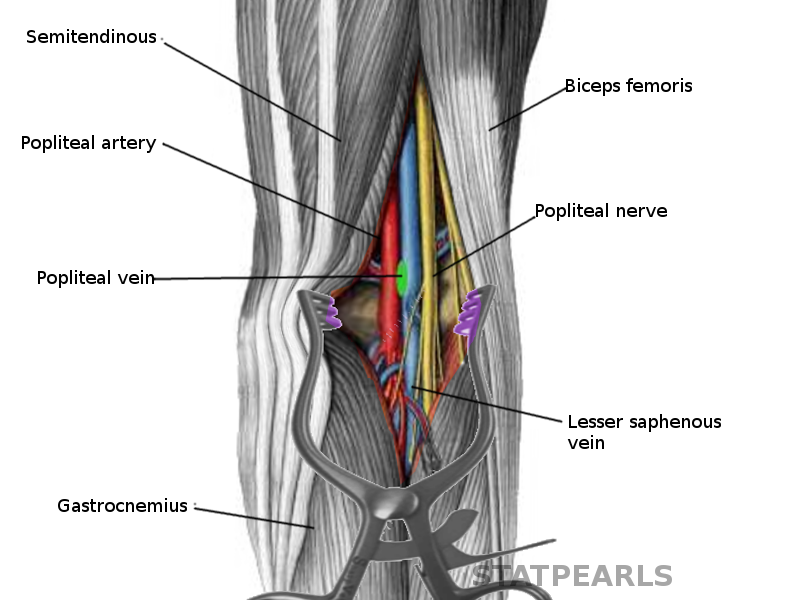[1]
Dagur G, Gandhi J, Smith N, Khan SA. Anatomical Approach to Clinical Problems of Popliteal Fossa. Current rheumatology reviews. 2017:13(2):126-138. doi: 10.2174/1573397112666161128102959. Epub
[PubMed PMID: 27894238]
[2]
Saavedra MÁ, Navarro-Zarza JE, Villaseñor-Ovies P, Canoso JJ, Vargas A, Chiapas-Gasca K, Hernández-Díaz C, Kalish RA. Clinical anatomy of the knee. Reumatologia clinica. 2012 Dec-2013 Jan:8 Suppl 2():39-45. doi: 10.1016/j.reuma.2012.10.002. Epub 2012 Dec 6
[PubMed PMID: 23219082]
[3]
Guidera KJ, Ganey TM, Keneally CR, Ogden JA. The embryology of lower-extremity torsion. Clinical orthopaedics and related research. 1994 May:(302):17-21
[PubMed PMID: 8168296]
[4]
Tomaszewski KA, Popieluszko P, Graves MJ, Pękala PA, Henry BM, Roy J, Hsieh WC, Walocha JA. The evidence-based surgical anatomy of the popliteal artery and the variations in its branching patterns. Journal of vascular surgery. 2017 Feb:65(2):521-529.e6. doi: 10.1016/j.jvs.2016.01.043. Epub 2016 Mar 16
[PubMed PMID: 26994952]
[5]
Shahid S, Saghir N, Cawley O, Saujani S. A Cadaveric Study of the Branching Pattern and Diameter of the Genicular Arteries: A Focus on the Middle Genicular Artery. The journal of knee surgery. 2015 Oct:28(5):417-24. doi: 10.1055/s-0035-1549021. Epub 2015 Apr 18
[PubMed PMID: 25892007]
[6]
Hirtler L, Lübbers A, Rath C. Vascular coverage of the anterior knee region - an anatomical study. Journal of anatomy. 2019 Aug:235(2):289-298. doi: 10.1111/joa.13004. Epub 2019 May 9
[PubMed PMID: 31070789]
[7]
Ma J, Ma T, Zhao X, Li YM, Wang R, Lü X. [The application of popliteal vein anatomy study and valve construction procedure]. Zhonghua wai ke za zhi [Chinese journal of surgery]. 2013 May 1:51(5):403-6
[PubMed PMID: 23958161]
[8]
Pan WR, Wang DG, Levy SM, Chen Y. Superficial lymphatic drainage of the lower extremity: anatomical study and clinical implications. Plastic and reconstructive surgery. 2013 Sep:132(3):696-707. doi: 10.1097/PRS.0b013e31829ad12e. Epub
[PubMed PMID: 23985641]
[9]
Yamazaki S, Suami H, Imanishi N, Aiso S, Yamada M, Jinzaki M, Kuribayashi S, Chang DW, Kishi K. Three-dimensional demonstration of the lymphatic system in the lower extremities with multi-detector-row computed tomography: a study in a cadaver model. Clinical anatomy (New York, N.Y.). 2013 Mar:26(2):258-66. doi: 10.1002/ca.22179. Epub 2013 Jan 22
[PubMed PMID: 23339085]
[10]
Norzana AG, Farihah HS, Fairus A, Teoh SL, Nur AK, Faizah O, Das S. Higher division of the tibial nerve in the leg: gross anatomical study with clinical implications. La Clinica terapeutica. 2013:164(1):1-3. doi: 10.7417/CT.2013.1501. Epub
[PubMed PMID: 23455733]
[12]
Watt T, Hariharan AR, Brzezinski DW, Caird MS, Zeller JL. Branching patterns and localization of the common fibular (peroneal) nerve: an anatomical basis for planning safe surgical approaches. Surgical and radiologic anatomy : SRA. 2014 Oct:36(8):821-8. doi: 10.1007/s00276-013-1242-x. Epub 2013 Nov 30
[PubMed PMID: 24292499]
[15]
Kil SW, Jung GS. Anatomical variations of the popliteal artery and its tibial branches: analysis in 1242 extremities. Cardiovascular and interventional radiology. 2009 Mar:32(2):233-40. doi: 10.1007/s00270-008-9460-z. Epub 2008 Nov 4
[PubMed PMID: 18982387]
[16]
Adibatti M, V S. Study on variant anatomy of sciatic nerve. Journal of clinical and diagnostic research : JCDR. 2014 Aug:8(8):AC07-9. doi: 10.7860/JCDR/2014/9116.4725. Epub 2014 Aug 20
[PubMed PMID: 25302181]
[17]
Faucett SC, Gannon J, Chahla J, Ferrari MB, LaPrade RF. Posterior Surgical Approach to the Knee. Arthroscopy techniques. 2017 Apr:6(2):e391-e395. doi: 10.1016/j.eats.2016.10.013. Epub 2017 Apr 3
[PubMed PMID: 28580257]
[18]
Ravn H, Wanhainen A, Björck M. Risk of new aneurysms after surgery for popliteal artery aneurysm. The British journal of surgery. 2008 May:95(5):571-5. doi: 10.1002/bjs.6074. Epub
[PubMed PMID: 18306151]
[19]
Johnston KW, Rutherford RB, Tilson MD, Shah DM, Hollier L, Stanley JC. Suggested standards for reporting on arterial aneurysms. Subcommittee on Reporting Standards for Arterial Aneurysms, Ad Hoc Committee on Reporting Standards, Society for Vascular Surgery and North American Chapter, International Society for Cardiovascular Surgery. Journal of vascular surgery. 1991 Mar:13(3):452-8
[PubMed PMID: 1999868]
[20]
Lawrence PF, Lorenzo-Rivero S, Lyon JL. The incidence of iliac, femoral, and popliteal artery aneurysms in hospitalized patients. Journal of vascular surgery. 1995 Oct:22(4):409-15; discussion 415-6
[PubMed PMID: 7563401]
[21]
Martelli E, Ippoliti A, Ventoruzzo G, De Vivo G, Ascoli Marchetti A, Pistolese GR. Popliteal artery aneurysms. Factors associated with thromboembolism and graft failure. International angiology : a journal of the International Union of Angiology. 2004 Mar:23(1):54-65
[PubMed PMID: 15156131]
[22]
Ascher E, Markevich N, Schutzer RW, Kallakuri S, Jacob T, Hingorani AP. Small popliteal artery aneurysms: are they clinically significant? Journal of vascular surgery. 2003 Apr:37(4):755-60
[PubMed PMID: 12663974]
[23]
Handy JR. Popliteal cysts in adults: a review. Seminars in arthritis and rheumatism. 2001 Oct:31(2):108-18
[PubMed PMID: 11590580]
[24]
Kim YC, Jung TD. Peroneal neuropathy after tibio-fibular fracture. Annals of rehabilitation medicine. 2011 Oct:35(5):648-57. doi: 10.5535/arm.2011.35.5.648. Epub 2011 Oct 31
[PubMed PMID: 22506187]

